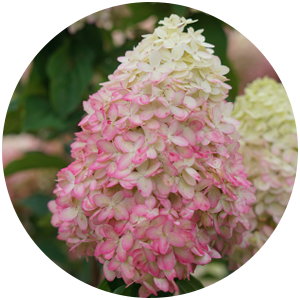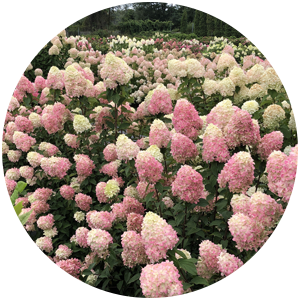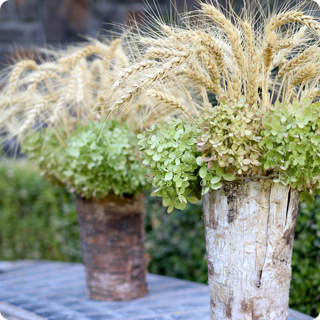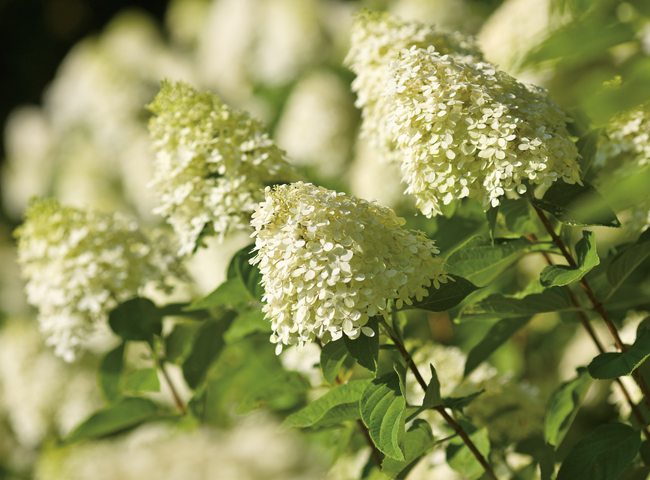LIMELIGHT PRIME®
hydrangea paniculata
A Classic Hydrangea Goes Prime Time
- Blooms reliably every year
- Earlier to bloom than ‘Limelight’
- Lime green flowers turn rich punch pink and red
- Strong stems keep the flowers upright
- No special soil required
- Strong grower in part sun to full sun
- 4-6’ tall x 4-5’ wide
- Hardy in USDA Zones 3-8
How do you top a classic? It took years to develop something that could be considered as garden worthy as the famous ‘Limelight’ hydrangea, but we’ve done it! Meet the greatly improved, award-winning Limelight Prime® panicle hydrangea. Here’s what you are going to love about this reinvented classic.
We’ve kept what you loved most about ‘Limelight’—its large, distinctive lime green flower panicles which mature to creamy white. But now, you’ll see them earlier in the season so you can enjoy them longer. Now, they’ll take on much richer punch pink and red tones as the blossoms mature and the nights get cooler.
This shorter, fuller selection also has healthy dark green foliage and much stronger stems which hold the flowers aloft for their entire color show. You won’t have to fight the urge to cut this hydrangea way back in hopes of its flowers holding up better—it will do so naturally. The flowers can be left perched for winter, bringing interest to your landscape as you take in the picturesque view from the warmth of your home.
how to grow limelight prime® hydrangea paniculata

Planting
Panicle hydrangeas are far less finicky about where they will grow than some other types of hydrangeas. Plant with confidence—you can do this!
In USDA zones 3-8, Limelight Prime panicle hydrangea will be vigorous and produce the most flowers if it is grown in full sun. In warmer zones, some afternoon shade is preferable to prevent the flowers from burning. No matter where you live, your hydrangea will benefit from a 2-3 inch layer of mulch to keep the roots cool and moist.
Panicle hydrangeas will tolerate most soil types as long as they are well-drained. This plant doesn’t grow well in soggy soil so if that sounds like yours, you may need to improve the drainage before planting. While many types of hydrangeas prefer acidic soil (pH less than 7.0), panicle hydrangeas can live in acidic and neutral (pH 7.0) soils.
When planting, dig the hole about twice as wide but just as deep as the container it is growing in. If the roots are densely circled around when you take the plant out of the pot, loosen them up a bit to break the “root memory”. This will encourage them to grow outward instead of continuing to grow in a circular pattern.
Set the plant in the hole, making sure that the top of the rootball is level with the top of the surrounding soil. Then backfill the hole with the soil you dug out. Press it down with your hand firmly to eliminate any big air pockets around the roots.
Lastly, water the plant again to help the soil settle. Spread some mulch around the base of the plant, taking care to keep it from touching the plant’s stems. The mulch will help to retain soil moisture and protect the roots during winter.

Pruning
Panicle hydrangeas like Limelight Prime produce their flowers on the current season’s stems. That means there’s no risk of the buds being damaged by winter—a useful trait for northern gardeners. As long as you prune them before late spring, you’ll see flowers that year.
You could prune Limelight Prime hydrangea in late fall once the plant goes dormant if you don’t want to keep its flowers for winter interest. We typically prune them in early spring so we can enjoy those blooms as long as possible. Cut the branches back by about 1/3 of their total length. This will help to create a fuller plant with larger blossoms. No other pruning should be needed throughout the growing season.
Early spring is a good time to scratch some granular plant food into the soil. We typically use one formulated for roses since hydrangeas enjoy similar nutrients. Doing so will encourage them to start the season off strong. No additional feeding is necessary.

Uses
Limelight Prime® panicle hydrangea’s shorter, fuller habit makes it easier to fit into most landscapes. You could plant a row of them along your home’s foundation where they will make a nice backdrop for flowering perennials and annuals. It also makes a fantastic hedge with the added bonus of abundant blooms from summer into fall. Perennial borders can be enhanced by making Limelight Prime a centerpiece, too.

Limelight Prime® Hydrangea paniculata pairs beautifully with a short hedge of deutzia
Recreate the look you see above by bordering your Limelight Prime panicle hydrangea with a short hedge of Chardonnay Pearls® Deutzia. Its shower of white spring flowers will bring interest to the space while your hydrangea is filling out its new foliage for the season, then complement Limelight Prime’s lime green blossoms with its matching chartreuse foliage.

Panicle hydrangea flowers work well in dried flower arrangements
Since it blooms on the same year’s growth, you won’t hurt this hydrangea at all if you cut its flowers in summer or fall for fresh and dried bouquets or to use in craft projects. And since there is such an abundance of flowers produced, you won’t even miss the ones you cut.
top 3 reasons to grow Limelight Prime® hydrangea
STRONGER, UPRIGHT FORM
Count on a reliable exhibition of blooms that stand up to be counted!
EARLIER BLOOM TIME
No more waiting until early fall to see flowers. This improved form starts blooming in midsummer.
BOLDER, BRIGHTER COLOR
Lime green flower panicles move from creamy white to rich punch pink and red tones for a dramatic show.

Limelight Prime® Hydrangea paniculata ‘SMNHPPH’ USPP 32,511, Can PBRAF
